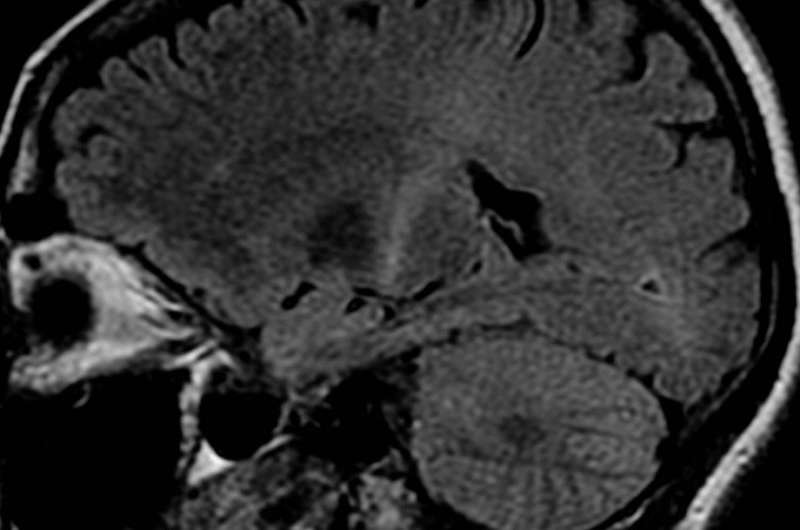An MRI with increased signal in the posterior part of the internal capsule which can be tracked to the motor cortex consistent with the diagnosis of ALS. Credit: Frank Gaillard/Wikipedia
A protein linked to amyotrophic lateral sclerosis (ALS), a progressive neurological disease that causes muscle weakness, may be a key to treating fibrotic disease of the kidneys and other organs, researchers at Vanderbilt University Medical Center reported recently.
FUS is the acronym of a protein in the nucleus of cells that regulates DNA repair transcription, RNA splicing and other functions. In the brain, mutations in FUS can damage nerves and cause ALS (also called Lou Gehrig's disease).
Fibrotic disease results from the excessive deposition of collagens and other structural proteins in the extracellular membrane (ECM) between cells. Fibrosis can lead to failure of the lungs, liver, kidneys and other organs.
Transmembrane receptors called integrins mediate interactions between cells and the ECM. One integrin down-regulates the activation of the epidermal growth factor receptor (EGFR), which promotes fibrosis. In the kidney, blocking this integrin or otherwise activating EGFR results in increased production of pro-fibrotic molecules including collagens.
Vanderbilt's Ambra Pozzi, Ph.D., and her colleagues hypothesized that integrin and EGFR regulate collagen production by "translocating" certain other proteins to the nucleus, where they interact with the collagen gene.
Pozzi is Professor of Medicine and of Molecular Physiology and Biophysics and a researcher at the Nashville Veterans Affairs (VA) Medical Center, part of the Tennessee Valley Healthcare System.
While looking for these proteins, she and her colleagues discovered a surprising connection between EGFR and FUS. It turns out in kidney cells EGFR phosphorylates (attaches phosphate groups to) FUS, thereby promoting its translocation to the nucleus, where FUS turns on collagen production.
Inhibiting EGFR, the researchers found, results in decreased nuclear translocation of FUS and reduced collagen production. A cell-penetrating peptide, or protein fragment, generated in collaboration with Distinguished Professor of Medicine Jacek Hawiger, MD, Ph.D., did the same thing: it also blocked FUS from entering the nucleus and restrained collagen levels.
"These findings offer a novel approach to limiting the fibrotic process in the kidneys and perhaps other organs," the researchers concluded.
While it remains to be determined whether and how such a peptide can be selectively guided to a specific organ that is affected by fibrosis, "we hope this study opens the door for future research focused on FUS as a novel pro-fibrotic target," Pozzi said.
Research fellow Manuel Chiusa, Ph.D., was first author of the paper published in the Journal of Cell Biology.
Journal information: Journal of Cell Biology
Provided by Vanderbilt University
























